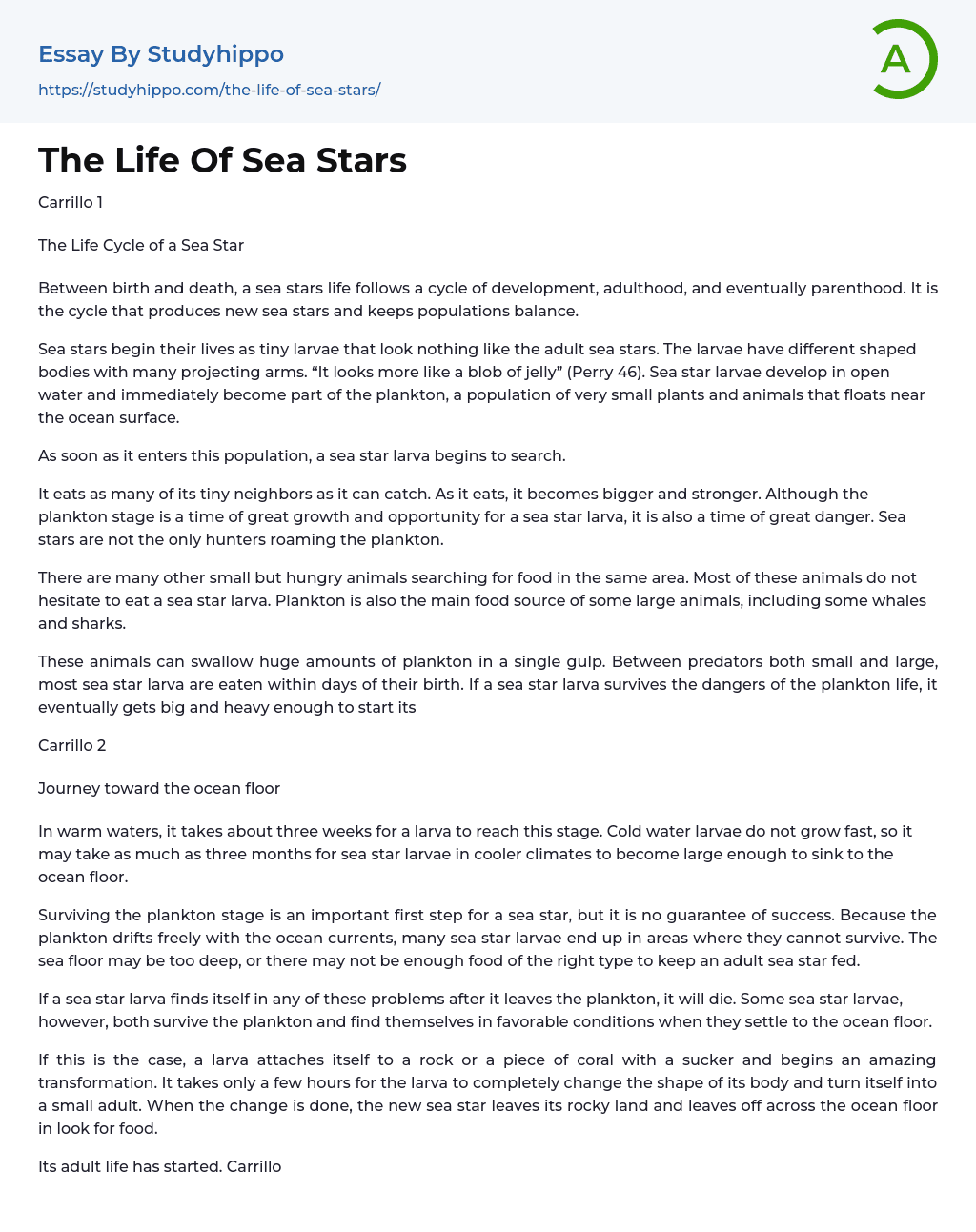Carrillo 1
The Life Cycle of a Sea Star
Between birth and death, a sea stars life follows a cycle of development, adulthood, and eventually parenthood. It is the cycle that produces new sea stars and keeps populations balance.
Sea stars begin their lives as tiny larvae that look nothing like the adult sea stars. The larvae have different shaped bodies with many projecting arms. “It looks more like a blob of jelly” (Perry 46). Sea star larvae develop in open water and immediately become part of the plankton, a population of very small plants and animals that floats near the ocean surface.
As soon as it enters this population, a sea star larva begins to search.
It eats as many of its tiny neighbors as it can catch. As it eats, it becomes bigger and
...stronger. Although the plankton stage is a time of great growth and opportunity for a sea star larva, it is also a time of great danger. Sea stars are not the only hunters roaming the plankton.
There are many other small but hungry animals searching for food in the same area. Most of these animals do not hesitate to eat a sea star larva. Plankton is also the main food source of some large animals, including some whales and sharks.
These animals can swallow huge amounts of plankton in a single gulp. Between predators both small and large, most sea star larva are eaten within days of their birth. If a sea star larva survives the dangers of the plankton life, it eventually gets big and heavy enough to start its
Carrillo 2
Journey toward the ocean floor
In warm waters, it
takes about three weeks for a larva to reach this stage. Cold water larvae do not grow fast, so it may take as much as three months for sea star larvae in cooler climates to become large enough to sink to the ocean floor.
Surviving the plankton stage is an important first step for a sea star, but it is no guarantee of success. Because the plankton drifts freely with the ocean currents, many sea star larvae end up in areas where they cannot survive. The sea floor may be too deep, or there may not be enough food of the right type to keep an adult sea star fed.
If a sea star larva finds itself in any of these problems after it leaves the plankton, it will die. Some sea star larvae, however, both survive the plankton and find themselves in favorable conditions when they settle to the ocean floor.
If this is the case, a larva attaches itself to a rock or a piece of coral with a sucker and begins an amazing transformation. It takes only a few hours for the larva to completely change the shape of its body and turn itself into a small adult. When the change is done, the new sea star leaves its rocky land and leaves off across the ocean floor in look for food.
Its adult life has started. Carrillo 3 It takes most sea stars one or two years to reach maturity after they become adult in form. When maturity is reached, it is time for a sea star to reproduce and create new sea stars. Nearly all sea stars reproduce by spawning.
This means that
females release eggs and males release sperm into the water around the same time. Most sea stars are nowhere each other when they spawn. The eggs and sperm meet up by chance as they float through the ocean. Spawning usually happens in the spring or early summer.
At these times of the year, light and temperature conditions bring about chemical changes in a female sea stars body. The chemical changes cause the female to release eggs. “A single female may produce over 2 million eggs in one spawn” (fact monster. com, sea star-reproduction).
Different species of sea stars release different numbers of eggs, but the numbers are usually large. Once released, the females eggs drift away on the ocean currents. With a little luck they will drift past male sea stars, who sense the eggs and release sperm in response. The sperm then fertilize the eggs, which eventually grow into brand new larvae.
Laboratory observations show that, at spawning, the males become restless and move around while the sperms are being discharged like white strings through the gonopores. In most cases about six to eight testes discharge at the same time.
- Rabbit essays
- Distribution essays
- Large Animals essays
- Mouse essays
- Poultry essays
- Animal Abuse essays
- Cats Vs Dogs essays
- Cattle essays
- Territory essays
- Microbiology essays
- Bacteria essays
- Cell essays
- Enzyme essays
- Photosynthesis essays
- Plant essays
- Natural Selection essays
- Protein essays
- Viruses essays
- Cell Membrane essays
- Human essays
- Stem Cell essays
- Breeding essays
- Biotechnology essays
- Cystic Fibrosis essays
- Tree essays
- Seed essays
- Coronavirus essays
- Zika Virus essays
- Agriculture essays
- Albert einstein essays
- Animals essays
- Archaeology essays
- Bear essays
- Biology essays
- Birds essays
- Butterfly essays
- Cat essays
- Charles Darwin essays
- Chemistry essays
- Dinosaur essays
- Discovery essays
- Dolphin essays
- Elephant essays
- Eli Whitney essays
- Environmental Science essays
- Evolution essays
- Fish essays
- Genetics essays
- Horse essays
- Human Evolution essays




